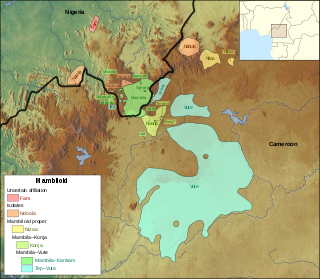Related Research Articles
The Bung language is a nearly extinct, endangered language of Cameroon spoken by three people at the village of Boung on the Adamawa Plateau. It is remembered best by one speaker who learned the language at a young age, though it is not his mother tongue. A wordlist shows its strongest resemblance to be with the Ndung dialect of Mambiloid language Kwanja, although that may simply be because this has become the dominant language of the village where Bung's last speakers reside. It also has words in common with other Mambiloid languages such as Tep, Somyev and Vute, while a number of words' origins remain unclear. For lack of data, it is not definitively classified.
Sardauna Local Government Area is located in the extreme southeast of Taraba State in Nigeria. It sits atop the Mambilla Plateau, which is dotted by other towns such as Maisamari and Nguroje. The capital of the LGA is Gembu, which is the principal town of various ethnic groups, such as Mambilla, Kaka, Fulani, Ndola, Tigon, Kambu, Chamba and Panso. Other ethnic groups from the mainstream Nigeria and the bordering Cameroon republic such as Hausa and Kanuri also live there.
The Mambilla or Mambila people of Nigeria live on the Mambilla plateau. A small fraction of Mambilla migrants left the Mambilla Plateau for the Ndom Plain on the Cameroon side of the international border as well as in a couple of small villages, such as New Namba, further north towards the towns of Gashaka and Banyo. The preferred ethnonym is spelt Mambila in Cameroon and Mambilla in Nigeria. "Norr" is also used.

The twelve Mambiloid languages are languages spoken by the Mambila and related peoples mostly in eastern Nigeria and in Cameroon. In Nigeria the largest group is Mambila. In Cameroon the largest group is Vute.
The Nimbari language, which is no longer spoken, was a member of the Leko–Nimbari group of Savanna languages. It was spoken in northern Cameroon. Ethnologue lists Badjire, Gorimbari, and Padjara-Djabi villages as Nimbari locations in Bénoué and Mayo-Louti divisions.
Wawa is a Mambiloid language spoken in a region of Cameroon and just inside bordering Nigeria used by about 3,000 people in three main dialects.
Mambila is a dialect chain stretching across Nigeria and Cameroon. It is one of the Mambiloid languages, a branch of Benue–Congo.
Tikar is a Northern Bantoid language spoken in Cameroon by the Bankim, Ngambe and related Tikar peoples as well as by the Bedzan Pygmies. Variants of the name are Tikali, Tikar-East, Tikari, Tingkala.
Vute is a Mambiloid language of Cameroon and Gabon, with a thousand speakers in Nigeria. The orthography was standardized on March 9, 1979. Noted dialect clusters are eastern, central, and Doume.
Ndoola (Ndoro) or Njoyamɛ in Cameroon]] is a Bantoid language of Nigeria, with a couple thousand speakers in Cameroon. It is either among or related to the Mambiloid languages.
Kwanja (Konja) is a Mambiloid language of Cameroon. Njanga (Nyanjang) is a distinct dialect.
Suga, also known as Galim, Nyemnyem, and Nizaa, is a Mambiloid language of Cameroon.
Mbongno (Bungnu), also known as Kamkam, is a Mambiloid language of Nigeria, with an unknown number of speakers in Cameroon.
Somyev (Somyewe), also known as Kila, is a nearly extinct Mambiloid language of two villages, one in Nigeria and one in Cameroon, that is spoken by a caste of blacksmiths that live among the Mambila. Although the language is still used for daily communication, the youngest generation of speakers were born in the 1950s. Transmission of the language ceased when the profession of blacksmithing lost its social status, partly due to imports of foreign tools.
Njerep (Njerup) is a Mambiloid language spoken in the Adamawa Region of Cameroon. Njerep is essentially extinct, with only 4 people who speak it at home. Though word lists and grammatical information have been collected from these people, the information remains fragmented.
Twendi, or Cambap as it is also known, is a nearly extinct Mambiloid language of Cameroon. Speakers have largely shifted to the closely related language Kwanja, and Twendi has not been passed down to children for decades. The language is spoken in the villages of Cambap and Sanga on the Tikar Plain by no more than 30 people, the youngest of whom were born in the 1940s.
The Kasabe language is an extinct language of Cameroon, formerly spoken around Mambila in the Nyalang area. The last speaker, a man named Bogon died on 5 November 1995.
Ndola People are found in Taraba, Nigeria and located in Kurmi and Ngada. Few are also found in Cameroon.
Northern Bantoid is a branch of the Bantoid languages. It consists of the Mambiloid, Dakoid, and Tikar languages of eastern Nigeria and west-central Cameroon.